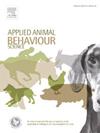搁浅鲸类动物的弹道安乐死的行为学和程序评估
IF 2.2
2区 农林科学
Q1 AGRICULTURE, DAIRY & ANIMAL SCIENCE
引用次数: 0
摘要
在鲸类搁浅事件中,安乐死可能是必要的,以结束痛苦。为了确保人道的死亡,必须在使用杀戮方法后进行无意识验证。然而,关于个别安乐死事件的报告信息有限,包括如何评估无意识和/或死亡。在这里,我们通过分析涉及不同物种的14个弹道事件的视频片段,描述了新西兰目前对搁浅鲸类实施安乐死的做法。具体来说,我们详细介绍了应用的弹道学程序和动物的行为反应。此外,我们试图通过调查相关人员来了解每次事件后如何评估动物的无意识。视频记录的长度从25秒到480秒 不等,涉及14种鲸目动物:一头居维叶喙鲸、一头侏儒抹香鲸、一头宽吻海豚、四只领航鲸和七只伪虎鲸。在分析的视频中,通常没有观察到昏迷标准得到证实,尽管射手说大多数动物在<; 1 分钟内死亡。注射到动物身上的次数从1-3次不等。表明无意识的主要行为包括持续松弛的下颌和外轴肌松弛。根据行为观察,66.7 %的动物(n = 12)可能在初始射击后30 秒内失去知觉;其中一半可能在10 秒内失去知觉。剩下的动物在第一次注射后30 秒内保持清醒,其中一半在一分钟后可能仍然清醒。10只动物在射击后表现出主动控制的行为,包括抬起尾巴,超出了射手报告的推定死亡点。大多数动物缺乏对无意识的验证(12/14),这阻碍了我们理解这些行为与意识之间的关系,从而影响了射击对福利的影响。虽然弹道学的应用似乎遵循了目前的国家建议,但很少遵守规定的核实死亡的程序。我们建议探索这一发现的原因,以确保这些程序得到适当实施,并尽量减少福利妥协。本文章由计算机程序翻译,如有差异,请以英文原文为准。
Ethological and procedural assessment of ballistics euthanasia for stranded cetaceans
Euthanasia may be necessary at cetacean stranding events to end suffering. To ensure a humane death, verification of unconsciousness must be undertaken following application of the killing method. However, only limited information is reported on individual euthanasia events, including how unconsciousness and/or death is assessed. Here, we describe current practices for euthanising stranded cetaceans in New Zealand by analysing video footage of fourteen ballistics events involving various species. Specifically, we detail the ballistics procedures applied and the behavioural responses of the animals. Additionally, we sought to understand how animal unconsciousness was evaluated following each event by surveying the personnel involved. Video recordings ranged in length from 25 to 480 s after the initial shot and involved 14 cetaceans: one Cuvier’s beaked whale, one pygmy sperm whale, one bottlenose dolphin, four pilot whales and seven false killer whales. Unconsciousness criteria were typically not observed being verified in the videos analysed, despite markspersons stating that death occurred in < 1 minute for most animals. Number of shots applied to an animal ranged from 1–3. Key behaviours indicative of unconsciousness included a continuously slack lower jaw and epaxial muscle relaxation. Based on behavioural observations, 66.7 % of animals for which an estimate could be made (n = 12) were likely unconscious within 30 s of the initial shot; half of these were likely unconscious within 10 s. The remaining animals appeared conscious for 30 s after the initial shot, and half of these were likely still conscious after one minute. Ten animals displayed post-shot behaviours suggestive of voluntary control, including tail lifting, beyond the point of presumed death reported by markspersons. The lack of verification of unconsciousness in most animals (12/14) hinders our ability to understand how these behaviours may correlate with awareness and thus welfare impacts of shooting. While the application of ballistics appeared to follow current national recommendations, mandated procedures for verifying death were rarely observed. We recommend exploring the reasons for this finding, to ensure that such procedures are appropriately undertaken, and welfare compromise minimised.
求助全文
通过发布文献求助,成功后即可免费获取论文全文。
去求助
来源期刊

Applied Animal Behaviour Science
农林科学-行为科学
CiteScore
4.40
自引率
21.70%
发文量
191
审稿时长
18.1 weeks
期刊介绍:
This journal publishes relevant information on the behaviour of domesticated and utilized animals.
Topics covered include:
-Behaviour of farm, zoo and laboratory animals in relation to animal management and welfare
-Behaviour of companion animals in relation to behavioural problems, for example, in relation to the training of dogs for different purposes, in relation to behavioural problems
-Studies of the behaviour of wild animals when these studies are relevant from an applied perspective, for example in relation to wildlife management, pest management or nature conservation
-Methodological studies within relevant fields
The principal subjects are farm, companion and laboratory animals, including, of course, poultry. The journal also deals with the following animal subjects:
-Those involved in any farming system, e.g. deer, rabbits and fur-bearing animals
-Those in ANY form of confinement, e.g. zoos, safari parks and other forms of display
-Feral animals, and any animal species which impinge on farming operations, e.g. as causes of loss or damage
-Species used for hunting, recreation etc. may also be considered as acceptable subjects in some instances
-Laboratory animals, if the material relates to their behavioural requirements
 求助内容:
求助内容: 应助结果提醒方式:
应助结果提醒方式:


